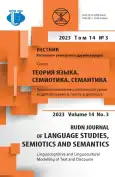Linguistic Means of Constructing ‘Enemy Number One’ in the US Cold War Cinema
- Авторлар: Kulikova M.N.1, Riabov O.V.2
-
Мекемелер:
- Saint Petersburg State University
- Herzen State Pedagogical University of Russia
- Шығарылым: Том 14, № 3 (2023): LINGUOCOGNITIVE AND LINGUOCULTURAL MODELLING OF TEXT AND DISCOURSE
- Беттер: 719-731
- Бөлім: COGNITIVE RESEARCH
- URL: https://journal-vniispk.ru/2313-2299/article/view/323413
- DOI: https://doi.org/10.22363/2313-2299-2023-14-3-719-731
- EDN: https://elibrary.ru/LBQIYY
- ID: 323413
Дәйексөз келтіру
Толық мәтін
Аннотация
The study examines how the US Cold War cinema employed linguistic means to construct images of the USSR and American communists. The research relevance is determined by: the need to study the techniques of creating the enemy image as one of the crucial issues in international relations; and the importance of the topic amidst the aggravation of Russia- US relations. The study aims at analysing the usage of linguistic means in such practices of constructing/deconstructing the images of ‘enemy number one’ as dehumanisation of the enemy, its normalisation, domestication, and rehumanisation. The research novelty lies in the fact that, for the first time, the language as a resource for constructing enemy images in the Cold War films is analysed. The material for the study makes American films of the 1940s-1960s, in which contaminated speech for depicting Soviet characters is extensively used. Particular attention is paid to the means of creating speech portraits of Soviet characters. The research methods used are descriptive, linguistic, and sociolinguistic methods, and discourse analysis. The authors conclude that linguistic means (primarily linguistic competences and accent) were instrumental for creating enemy images in the cinematic Cold War. Linguistic otherness served as a means of emphasising second-rate culture, which in turn was intended to mark political foreignness. Linguistic means helped fulfil functions of the enemy image: showing its otherness; depriving it of the linguistic abilities as an essential attribute of humanity, helping dehumanise it; emphasizing its civilisational inferiority; and making the enemy comical. Finally, attention is drawn to the fact that the cinematic image of ‘enemy number one’ contributed to the hierarchisation of languages; everything Russian was associated with communism and therefore perceived as inferior and hostile.
Авторлар туралы
Marina Kulikova
Saint Petersburg State University
Хат алмасуға жауапты Автор.
Email: m.kulikova@spbu.ru
ORCID iD: 0000-0003-2501-9894
SPIN-код: 8785-2770
PhD in Philology, Associate Professor in the Department of English in Philology and Arts
7-9, Universitetskaya Embankment, St. Petersburg, Russian Federation, 199034Oleg Riabov
Herzen State Pedagogical University of Russia
Email: Riabov1@inbox.ru
ORCID iD: 0000-0002-5944-9668
SPIN-код: 6502-7446
Scopus Author ID: 35096463200
ResearcherId: E-2527-2016
D.Sc. (Philosophy); Professor; Leading Researcher at Department of History and Social Sciences
48, Moika Embankment, St. Petersburg, Russian Federation, 191186Әдебиет тізімі
- Rieber, R.W. & Kelly, R.J. (1991). Substance and Shadow: Images of the Enemy. In: Psychology of War and Peace: The Image of the Enemy, R.W. Rieber (Ed.). New York: Plenum. pp. 3-39.
- Griffith, R. (2001). The Cultural Turn in Cold War Studies. Reviews in American History, 29(1), 150-157.
- Shaw, T. (2007). Hollywood’s Cold War. Edinburgh: Edinburgh UP.
- Kenez, P. (1992). Cinema and Soviet Society, 1917-1953. Cambridge: Cambridge UP.
- Shaw, T. & Youngblood, D.J. (2010). Cinematic Cold War: The American and Soviet Struggle for Hearts and Minds. Lawrence: University Press of Kansas.
- Fyodorov, A.V. (2010). Images of the cold war: projection of the confrontation politics on the screen. Polis. Political Studies, 4, 48-64. (In Russ.).
- Riabov, O. & Riabova, T. (2021). The Images of Urban Space in Constructing the Cold War Enemy: US Skyscrapers in Soviet Animation. Studies in Russian and Soviet Cinema, 2, 122-138. https://doi.org/10.1080/17503132.2021.1905792
- Fairclough, N. (1989). Language and power. London: Longman.
- Culpeper, J. (2001). Language and characterisation: People in plays and other texts. Harlow: Pearson Education.
- Phillipson, R. (1992). Linguistic imperialism. Oxford: Oxford University Press.
- Androutsopoulos, J. (2012). Introduction: Language and society in cinematic discourse. Multilingua, 31(2), 139-154.
- Bleichenbacher, L. (2008). Multilingualism in the movies: Hollywood characters and their language choices. Tübingen: Narr Francke Attempto Verlag.
- Bleichenbacher, L. (2012). Linguicism in Hollywood movies? Representations of, and audience reactions to multilingualism in mainstream movie dialogues. Multilingua, 31(2), 155-176.
- Taavitsainen, I. & Melchers, G. (1999). Writing in Nonstandard English: Introduction. In: Irma Taavitsainen, Gunnel Melchers & Päivi Pahta (eds.), Writing in Nonstandard English. Amsterdam/Philadelphia: John Benjamins. рр. 1-26.
- Lippi-Green, R. (1997). English with an accent: Language, ideology, and discrimination in the United States. London & New York: Routledge.
- Lawless, K. (2014). Constructing the ‘other’: construction of Russian identity in the discourse of James Bond films. Journal of Multicultural Discourses, 9(2), 79-97. http://dx.doi.org/10.1080/17447143.2014.894517
- Vartanova, E. (2014). Constructing ourselves through constructing others: Journal of Multicultural Discourses, 9(2), 98-103. https://doi.org/10.1080/17447143.2014.923434
- Ono, K.A. (2014). Response to ‘constructing the ‘other’: construction of Russian identity in the discourse of James Bond films. Journal of Multicultural Discourses, 9(3), 265-268. https://doi.org/10.1080/17447143.2014.946420
- Campbell, D. (1992). Writing Security: US Foreign Policy and the Politics of Identity. Manchester: Manchester University Press.
- Haslam, N. (2006). Dehumanization: An Integrative Review. Personality and Social Psychology Review, 10(3), 252-264.
- Sharp, J. (2000). Condensing the Cold War: Reader’s Digest and American Identity. Minneapolis: University of Minnesota Press.
- Riabov, O. (2021). Rehumanization of ‘them’: evolution of representations of the ‘enemy number one’ in American Cold War cinema. Dialogue with Time, 77, 277-290. https://doi.org/10.21267/AQUILO.2021.77.77.018 (In Russ.).
- Shaw, T. (2010). The Russians Are Coming The Russians Are Coming (1966): Reconsidering Hollywood’s Cold War ‘Turn’” of the 1960s. Film History, 22(2), 235-250.
Қосымша файлдар









